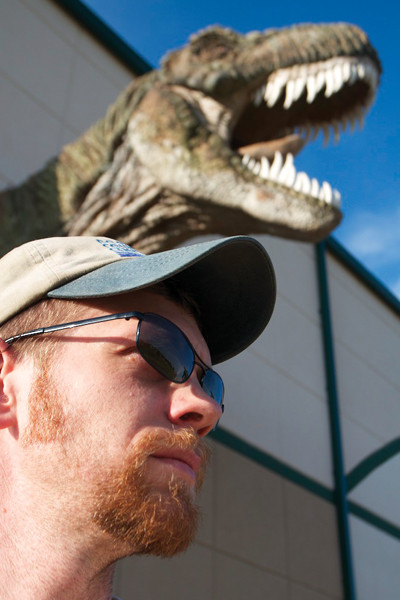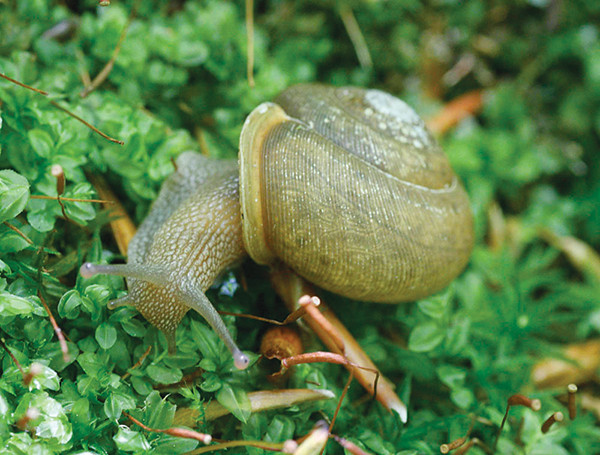
by Timothy Oleson Tuesday, January 27, 2015

Credit: ©Matt Kuchta.
Matt Kuchta is the geology program at the University of Wisconsin at Stout (UW-Stout), located in Menomonie, Wis. It’s a young program: Kuchta is in just his second year as a tenure-track assistant professor, after working as an adjunct instructor at the undergraduate instruction-focused school for two years while pursuing a doctorate in geology from the University of Wisconsin at Madison, which he received in 2009.
The position occupies the bulk of his time, although that doesn’t bother him too much. When he’s not teaching or cooking up demonstrations to illustrate the cooler aspects of earth science for in-class or online audiences, he finds time for scientific outreach — talking to second-graders about dinosaurs, for example — and pursues his research interests, which he describes as “some sort of Frankenstein hybrid of paleobiology and physical ecology.” In a word, though: snails.
Occasionally, he happens upon some free time, which he often occupies by jury-rigging scientific devices, photographing nature at its finest, or tending the family vegetable garden. Between an appearance at a steampunk-themed science fiction and fantasy convention (think Jules Verne’s Nautilus submarine and other elaborate visions of futuristic technology as seen through a distinctly 19th-century lens) and a vacation trip to Glacier National Park last summer, Kuchta talked with EARTH’s Timothy Oleson about balancing life and work expectations as a young teacher and researcher, being a “snail guy,” and his experience as a geoblogger.
TO: After a year as a tenure-track faculty member at UW-Stout, have you learned any important lessons about being a professor and researcher?
MK: The biggest one is probably that you can’t do everything, because then you’ll never do anything because you’re always trying to do something else.
People say a professor’s responsibilities are like a stool with three legs [teaching, research, and service/outreach], and each leg needs some attention. At the large research universities, the research leg of the stool is much larger. At the teaching schools, the teaching side of things would be much larger.
TO: How do you split time between teaching and research, and where does your preference lie?
MK: During the school year, I’d say my time is at least 50 percent teaching. That’s not just butts-in-seats in the classroom, but also grading and answering questions, developing lectures and writing laboratories, and all the other trappings that go along with teaching. Some of my time is [also spent doing] outreach.
I would consider myself happy during the week if I can get maybe a quarter to a third of my time devoted to research interests during the school year. During the summer, I’m spending 100 percent of my time doing research.
If you take it as a lump sum, it’s probably 60 percent teaching, 10 to 15 percent service and outreach, and then 25 to 35 percent research. You move the sliders around as needed.

The subject of most of Kuchta's research: snails, both fossilized and modern. Here, it's a living Mesodon thyroidus that caught his eye. Credit: ©Matt Kuchta.
TO: Your research has focused mainly on snails, correct?
MK: Yup. At some point during my graduate school career, I managed to become known as the snail guy.
TO: Was it something you fell into, or have you always been into gastropods?
MK: I was one of those people who was dead set on being a geology major right from the start, but my first interest was dinosaurs. And then once I took introductory geology, historical geology, sedimentology and all those other classes, I became a little bit more enamored of the spineless contingent in the fossil record. I did a master’s project in the Green River Formation [in Wyoming] on the lacustrine gastropods there, and that got me thinking about snails.
TO: What can you learn from snails?
MK: Some of the classic paleoecology proxies — charcoal and pollen, for example — aren’t well-preserved in some places, like alkaline Quaternary-aged sediments. Snail shells do rather well in alkaline sediments so they become a source of proxy data in places where no other proxy data might exist.
Snails tend to stick around in one place; they’re not terribly mobile organisms on the individual scale. Whatever habitats or environmental characteristics they’re picking from are fairly local in nature. It’s not like they’re living in Wisconsin during the summer and then moving to Florida in the winter. They’re stuck there year-round. So, they’re local indicators of environment.
Their shells are basically a geochemical record of various processes. The carbon in the shell, for at least some species, is derived almost exclusively from plant material, and that carbon is derived from the atmosphere. So some species of snails do a good job of just recording atmospheric carbon, which means that they provide pretty reliable radiocarbon dates.
TO: What are you working on currently?
MK: There’s a big gap in our understanding of what snail species are living in [western Wisconsin] today. Thanks to a grant from the Wisconsin Department of Natural Resources, my wife, an ecologist also at UW-Stout, and I developed a GIS-based habitat model that compiles existing species distribution records and compares these records to spatial landscape and ecology data. The model creates a probability map showing where these factors are favorable for a particular species of snail. It’s exciting to contribute to the long-term protection of biodiversity in the area. Plus, by knowing more about the ecology of modern snails, I can better understand what ecological data can be extracted from the deposits of fossil snails.
TO: I wanted to ask about your blog, which is fittingly named “Research at a Snail’s Pace.” I take it that comes from the quote, “If you aren’t moving at a snail’s pace, you aren’t moving at all,” attributed on your blog to Iris Murdoch?
MK: Yes, the Irish poet/writer who had communist sympathies and was kind of an interesting character. I wasn’t aware of her full biography at the time, but I think the quote is rather fitting.
There’s the tongue-in-cheek aspect because it sometimes feels like you’re not getting anywhere even though you’re getting a lot done. It’s a poignant reminder, but also it’s like I’m sticking my tongue out at the idea that we have to produce more and more. I have to constantly check myself to make sure that I get one thing done before I start something new.
The longer-term benefit of the blog has been to make connections with other geologists and to provide something that a lot of media don’t do well: thoughtful interpretations of fairly complex topics like evolution and climate change.
TO: You partly answered my next question, but what’s your opinion about the value of science blogging? Does it cause more clarity or confusion?
MK: The benefit to the greater community comes from the consensus of voices talking about science, as well as the chaff being shown for what it is. It’s a challenge to separate the signal from the noise. The stronger the signal is, the better the chance for that to overcome the noise.
I think the bloggers can’t afford to ignore the media. But I also think the media can’t afford to ignore the bloggers because we’re both playing a role in the larger cultural dialogue that talks about science and why science is important and why understanding how Earth works isn’t a bad use of our funds. Being able to work in parallel, if not together, makes for a more informed public.
TO: What was your experience discussing evolution with other scientist-bloggers at the recent CONvergence [science fiction and fantasy] convention?
MK: Being more on the paleontology [rather than biology or anthropology] side of things, I was able to bring in the fossil record and the concept of “What do we get if we look at this from a really large-scale perspective?” We were up there for an hour, but we probably could’ve spent a couple of days talking about stuff. That was pretty fun.
I actually did another panel that was basically, “How do you deal with maps in a fantasy novel?” My perspective was to describe what I did when I was making some maps for one of my friend’s novels. Knowing what I know about how Earth works, I revised the rivers so that their shape was correct. I threw in a few ideas of my own about what the geomorphology of the place might be like based on where the mountains and where the rivers are. That map is actually going into the book [“Broken Blade,” by Kelly McCullough] that will be coming out at the end of November.
TO: Aside from teaching, researching, blogging and illustrating maps for sci-fi novels, you’re also an avid nature photographer. Do you have a philosophy for balancing all your interests?
MK: I keep reminding myself that there is a finite amount of time in the day and if I do nothing but sit in a lab, I’m not going to be very happy. I try to keep what I do as a professional geologist isolated in terms of the time that I am actively participating in it. Of course, the key word there is “try.” Yoda was wrong; there is just “try.”
© 2008-2021. All rights reserved. Any copying, redistribution or retransmission of any of the contents of this service without the expressed written permission of the American Geosciences Institute is expressly prohibited. Click here for all copyright requests.